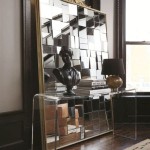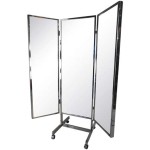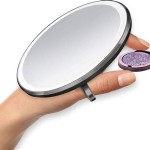Hanging Bathroom Mirrors On Tiles
Installing a bathroom mirror involves more than just aesthetics; it's a functional necessity. Successfully mounting a mirror on tiled walls requires careful planning and execution to avoid damaging the tiles and ensure a secure, long-lasting hold. This article outlines the process, highlighting key considerations and best practices.
Key Considerations Before Starting
Several factors influence the mirror hanging process. Assessing these beforehand ensures a smooth and successful installation.
- Mirror Weight and Size: Heavier and larger mirrors require more robust mounting solutions.
- Tile Type and Condition: Porcelain and ceramic tiles offer different drilling challenges. Existing cracks or damage in the tiles need addressing before hanging.
- Wall Structure: Ensure the wall behind the tiles can support the mirror's weight. Stud walls require different mounting methods than solid walls.
- Desired Mirror Placement: Consider the height of users and the overall bathroom layout.
- Bathroom Environment: The humid environment necessitates moisture-resistant materials and techniques.
Essential Tools and Materials
Gathering the correct tools and materials beforehand streamlines the installation process.
- Measuring Tape and Pencil: Accurate measurements are crucial for proper placement.
- Level: Ensures the mirror hangs straight.
- Drill with Tile/Glass Drill Bit: Prevents tile cracking during drilling.
- Masking Tape: Protects the tile surface and helps prevent drill slippage.
- Wall Anchors (if necessary): Provide additional support, especially in hollow walls.
- Screws: Choose screws appropriate for the wall type and mirror weight.
- Mirror Adhesive (optional): Adds extra security and stability.
- Safety Glasses and Gloves: Protect against dust and potential injuries.
- Mirror Clips or J-Channels (optional): Provide additional support and a cleaner finish.
Step-by-Step Hanging Process
Following a systematic approach is crucial for a successful installation.
- Mark the Desired Location: Use a pencil and level to mark the mirror's position on the tiles.
- Apply Masking Tape: Place masking tape over the marked drill points. This helps prevent the drill bit from slipping and reduces the risk of tile damage.
- Drill Pilot Holes: Using a tile/glass drill bit, carefully drill pilot holes through the tiles and into the wall. Use a slow drill speed and light pressure to avoid cracking the tiles.
- Insert Wall Anchors (if necessary): If the wall is hollow or the mirror is particularly heavy, insert appropriate wall anchors into the drilled holes.
- Apply Mirror Adhesive (optional): For added security, apply a thin layer of mirror adhesive to the back of the mirror.
- Attach the Mirror: Carefully align the mirror with the drilled holes and attach it to the wall using screws. Ensure the screws are tightened securely but not over-tightened, which could crack the mirror or tiles.
- Install Mirror Clips or J-Channels (optional): These provide extra support and a more polished look by concealing the mounting hardware.
Choosing the Right Mounting Method
Different mounting methods suit different scenarios. Selecting the appropriate one ensures a secure and stable installation.
- Screws and Wall Plugs: A reliable method for most installations, particularly for heavier mirrors. Choose appropriate wall plugs for the wall type.
- Adhesive: Suitable for lighter mirrors and provides a clean look without visible fixings. Ensure the adhesive is compatible with both the mirror and the tiles.
- Clips and Channels: Offer additional support and a finished look, especially for larger mirrors. These can be used in conjunction with screws or adhesive.
- Combination Methods: For very heavy mirrors, combining adhesive with screws and clips ensures maximum stability.
Dealing with Different Tile Types
Different tile materials require slightly different approaches during the drilling process.
- Ceramic Tiles: Generally easier to drill than porcelain, but still require a specialized tile drill bit and careful handling.
- Porcelain Tiles: Denser and harder than ceramic tiles, requiring a diamond-tipped drill bit and slower drilling speeds.
- Glass Tiles: Require specialized glass drill bits and extreme caution to prevent cracking. Consider using adhesive mounting for smaller glass mirrors.
Troubleshooting Common Issues
Addressing potential issues beforehand can prevent problems during and after installation.
- Cracked Tiles: Use a slow drill speed and light pressure to minimize the risk. If a crack occurs, the tile may need replacing.
- Loose Mirror: Ensure appropriate wall anchors are used for hollow walls and that screws are tightened securely.
- Uneven Mirror: Use a level throughout the installation process to ensure proper alignment.
- Damaged Wall: Choose the right mounting method for the wall type and consider reinforcing the wall if necessary.
Maintaining Your Bathroom Mirror
Proper maintenance ensures the longevity and appearance of your bathroom mirror.
- Regular Cleaning: Use a non-abrasive glass cleaner and a soft cloth.
- Check for Loose Fittings: Periodically check the screws and clips to ensure they remain tight.
- Avoid Excessive Moisture: Ensure adequate ventilation in the bathroom to minimize moisture buildup on the mirror and surrounding tiles.

How To Hang Mirrors On Tile 3 Ways A Bonus The Palette Muse

How To Hang A Mirror On Tile Wall Remington Avenue

How To Hang Mirrors On Tile 3 Ways A Bonus The Palette Muse

How To Hang Mirrors On Tile 3 Ways A Bonus Hanging Mirror Round Bathroom Heavy

How To Hang A Bathroom Mirror Over Tile Wainscoting Mimzy Company

36 X 24 Inches Large Bathroom Makeup Mirror Modern Rectangle Black Wall Mounted With Aluminum Frame Vertical Or Horizontal Hanging Decorative Mirrors For Vanity Living Room Bedroom Com

Mirrors Hanging Over Vanity Mirror Design Ideas

Tutorial How To Hang A Bathroom Mirror The Diy Playbook

How To Hang A Bathroom Mirror On Ceramic Tile Inspiration Design Minimalist

How To Hang A Bathroom Mirror Over Tile Wainscoting Mimzy Company








